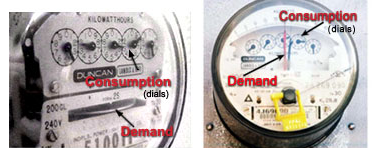Home › Electrical Engineering Forum › General Discussion › Tariff and metering for low voltage systems
- This topic has 0 replies, 1 voice, and was last updated 10 years, 1 month ago by
admin.
-
AuthorPosts
-
2015/01/05 at 9:36 am #11224
admin
KeymasterLet Marvin tell you about reducing power losses and remember that you too can send us your articles by mail.
Different countries, regions, and power utility companies use different variables for billing and tariff structures. The primary objective of this article, thus, is not to focus on particular tariffs, rather, the basic elements that permeate across all the regions.In short, I seek to highlight the two fundamental ways to reduce peak power demand and power losses in the generation and transmission.
Power Peak Demand Reduction
To get the most out of the generation and transmission company, the primary objective is to reduce power peak demand while seeking higher demand during the low load periods. Most power utility companies offer reduced tariffs at specified times of the day and year. Do note that the higher the peak demand, the higher the bill amount.
For large industries operating on LV and MV, there may be as many as four different rates used for calculation in the course of the day. The primary objective of the attending engineer is to get the maximum load, or shift the loads to maximize on the lowest rates.
Losses Reduction
In most of the regions, the tariff structures are based on kVA demand, as well as the kWh units. With this in mind, the primary objective is to improve the load power factor, since the lowest billing occurs close to unity power factor.
In most regions, the total bill on LV systems is a total of maximum kVA demand over specified periods, in most cases 10 to 60 minute periods. The highest average is used for the calculation.
Metering
Meters are high precision electro-mechanical and electronic equipment. For LV systems, the installed meter measures the highest average KVA demand during the billing interval as well as the maximum level of active power usage (kW). Each region has a set demand charge per KVA. The bill thus takes the following form.
Demand Charge=Demand Charge/kVA x Peak Demand (KVA)
Do note that if the Peak Demand value is higher than the contracted amount, and then there is penalty.
How Reactive Power Applies in Metering
All meters record reactive power, including residential consumers. Reactive power is ignored for residential consumers. The charge on reactive power only applies for the industrial consumers, due to the large number of equipment such as motors that require reactive power to operate. In such cases, the reactive power is measured separately from the general units.
It is important to note that the charge on the reactive power takes effect only if the amount is more than a third of the active power. Do note that this charge comes about because, the higher the reactive power, the more the current required to attain the standard power input.
In some regions, some power distribution companies just estimate the reactive power amount based on an assumed power factor. This is especially so for the old meter configurations. The ideal solution is to arrange for a meter replacement or meter reprogramming for figures that are more accurate.
However, if you suspect that the bill amount based on the estimation is far less that you think you should pay, I see no need to pursue corrective measures.
Marvin M.
-
AuthorPosts
- You must be logged in to reply to this topic.
